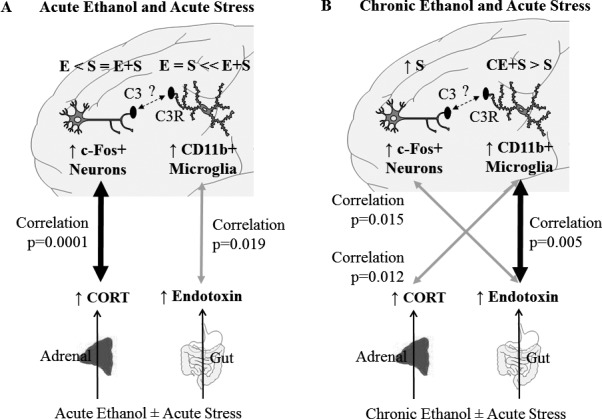Figure 10.

Effects of acute and chronic ethanol (EtOH) on the systemic and central nervous system response to acute stress. (A) Both acute EtOH and acute stress increase plasma CORT and neuronal c‐Fos in the PFC. The magnitude of these effects is represented by E < S = E+S. Furthermore, CORT and PFC c‐Fos levels correlate, suggesting these 2 responses are related. This positive correlation is represented by the thick arrow, and the p‐value for the Pearson correlation is displayed. Furthermore, acute EtOH and acute stress alone have little effect on plasma endotoxin or microglial CD11b in the mPFC. However, acute EtOH and acute stress together interact to enhance plasma endotoxin and microglial CD11b in the PFC. This is represented by E = S << E+S. Plasma endotoxin and PFC CD11b also correlate. This positive correlation is represented by the thin arrow, and the p‐value for the Pearson correlation is displayed. A possible interaction between microglial CR3 and neuronal C3 is also displayed. Increased CD11b, a component of CR3, may contribute to change synaptic remodeling. (B) Acute stress increases plasma CORT and PFC c‐Fos, but this is not altered by prior chronic EtOH, as indicated by ↑S. However, chronic EtOH enhances the plasma endotoxin and PFC CD11b response to acute stress. This is represented by CE + S > S. Plasma endotoxin and microglial CD11b also correlate, consistent with endotoxin‐induced microglial activation. This correlation is represented by the thick arrow, and the p‐value of the Pearson correlation is shown. Interestingly, the plasma endotoxin and PFC c‐Fos response also correlate. This is represented by the thin arrow, and the p‐value for the Pearson correlation is shown. Furthermore, the plasma CORT response correlates with the PrL CD11b response. This is represented by the thin arrow, and the p‐value of the Pearson correlation is shown. A possible interaction between microglial CR3 and neuronal C3 is also displayed. Increased CD11b, a component of CR3, may contribute to change synaptic remodeling.
